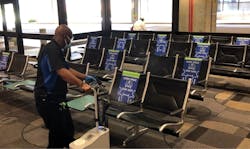Switching Seats: COVID-19’s Impact on the Terminal
The COVID-19 pandemic has changed the world and it’s not done yet. As guidelines change and the concerns of passengers wax and wane, airports are doing their best to keep up with the shifting landscape. Everything from the way passengers sit and stand in the terminal, to how they interact with gate agents and security is different than when it was at the beginning of the year – and will keep on changing.
At the Tampa International Airport (TPA), Emily Nipps, senior communications manager, explained how from the outset of the pandemic, the airport’s CEO Joe Lopano was part of the Florida Governor’s task force to reopen the state. Lopano was able to hear firsthand the best practices to incorporate.
“He basically brought some of that back to our airport. We went ahead, without looking for any guidance from the state or guidance from the airline or other airports. We created our own plan that we felt would incorporate some of these best practices. That included putting up acrylic shields at various countertops, points where people are interacting, like ticket counters, our information kiosks, in places like concessions. Then also ordering thousands of floor decals and begin applying and in places where it made sense,” said Nipps.
The floor decals are found throughout the ticketing areas, outside and inside of shuttles and in the lines at the TSA checkpoints and stores, helping guide people on where to stand and keep socially distance.
Distance is the keyword when it comes to TPA’s seating as well, as the airport has taken steps to ensure the proper social distancing guidelines can be followed by passengers even as they take a load off.
“We've got every other seat spaced out. We've got markers on the seats, basically telling people not to sit in those seats, so we can maintain the six-foot distance. Obviously, families that are traveling together, they can sit together. So far, people are doing a pretty good job of staying separated,” Nipps explained.
Seating changes have been taken under by the Orlando Melbourne International Airport (MLB) too, but where TPA marked their seating off, MLB went a step farther.
“We have removed approximately 30 percent of our seating throughout the airport to ensure our passengers are able to comfortably be physically distant from one another. Additionally, seating in the passenger boarding areas no longer have back-to-back seating and all seats now face the same direction towards windows, similar to a theater,” said Rob Himler, MLB’s manager of marketing and communications.
Prior to the change, Himler said there was an overabundance of passenger seating throughout the concourse.
“It was crowded and mostly situated back-to-back and facing one another,” he continued. “Being a less congested airport allowed us to make these changes and have the ability to make them permanent. We will continue as long as it provides a safe environment for travel. It has also given us the opportunity to remove outdated seating and make repairs.”
Other initiatives MLB has enacted include physical distancing visual guides, terminal seating and queue reconfiguration and an online resource for travelers to use to prepare for their next journey and learn all that MLB has done.
To meet the challenges and address the new normal of the COVID-19 world, MLB has put together a dedicated taskforce to tackle all that the pandemic has and will bring, as well as address the evolving public health guidelines around it.
“The task force is made up of several department directors and managers to brainstorm, explore and implement ways to make the journey at our airport safer, better and more convenient. We began with outlining the overall strategy and implemented what we could accomplish immediately including enhanced cleaning procedures, communication and staffing,” Himler said.
Meeting the New Normal
Prior to COVID-19’s outbreak, Lynn Gordon, vice president of business development, Arconas, said airport seating was already beginning to trend in a new direction.
“In the past several years we have seen an increased demand for a mixture of seating, with more lounge pieces accompanying traditional tandem seating. There has also been a trend toward creating separate seating zones, such as family pods, business zones with charging stations along with general beam seating,” Gordon said.
The trend was born out of airports wanting to meet the diverse needs of their guests and having a variety of options to make everyone feel comfortable. Gordon said this included seating that allowed for more personal space through the use of tables, tablet arms, ‘clusters’, acoustic panels, planters and other design features; all trends continuing into the COVID-19 world and beyond.
“Creating layouts that allow for flexibility and, where practical, more personal space will continue be a trend,” Gordon said.
Sensible solutions that allow flexibility, Gordon stressed, is key to the future success of airport seating and terminal design, so airports can easily change configurations to meet the evolving guidelines and public health concerns without creating new problems. Seats can be equipped with temporary slip covers that encourage social distancing but keep the seat usable so that families can still sit together. She suggests using screens selectively and strategically when required seating density doesn’t allow for comfortable distances, such as between back-to-back rows.
“No-one wants to see passenger terminals turn into hospitals and few people want to sit or live in ‘bubbles’,” Gordon said.
Of course, there is more to combating the virus than the arrangement of seating – disinfecting is high priority – and having fixtures that are easy to clean will be part of the battle moving ahead.
“We also believe that the choice of materials and ease of cleanability will be very important. There was a trend happening recently towards more woven fabrics on lounge pieces that are harder to clean,” Gordon said.
Instead, she believes they will see more seating in non-porous upholstery like vinyl or faux leather, polyurethane, metal or wood, as these are all easily cleaned and disinfected.
“A main concern for airports is keeping up with frequent cleaning and disinfecting of the furniture. Because of this, it’s best to have furniture that is easily wiped and disinfected to keep O&M costs in check,” said Gordon.
All of Arconas’ seating lines have the option to be upholstered in fabrics with anti-microbial properties that can easily be wiped and cleaned. It is recommended to disinfect vinyl upholstery with a 10 percent bleach and 90 percent water solution. A solution of soap and water will also clean the upholstery. All of the company’s metal components can also easily be cleaned with soap and water or a non-abrasive all-purpose cleaner, and their polyurethane seats have integral anti-microbial properties and are easily disinfected. Treated wood and metal seating are also good alternatives as they can easily be wiped clean and disinfected, noted Gordon.
These adaptions can also be brought to other areas of the terminal, such as shared amenity areas like charging stations and kiosks.
“Charging stations and kiosks should be made from materials that are easily wiped and disinfected. We don’t see these amenities falling out of use. Passengers will more likely be encouraged to keep their distance, and wash or disinfect their hands. These areas may need to see an increase in washing and disinfecting stations,” Gordon said.
Beyond the Seat
Keeping passengers feeling safe involves more than seating, with the protocols to address COVID-19 impacting an airport’s entire operation.
“Now more than ever, travelers are looking for trustworthy communication, safety updates, and they are seeking to have confidence in their airport. Travelers want to feel safe along every step of their journey and it’s important the airport evaluates where it can be improved from terminal door to aircraft door and everywhere in between,” said Himler.
Aside from the steps MLB has so far taken, Himler said the airport is in the planning and design phase of a major terminal renovation and expansion project and are taking the lessons from COVID-19 into consideration.
“We are using this as an opportunity to discover and implement the latest health technologies, touchless equipment, faster processing with advanced biometrics, better queuing, and a spacious terminal layout that allows travelers to be physically distant,” Himler added.
For TPA, Nipps said that passengers took to the changes at the airport right away, following the airports signage on social distancing and following new rules such as asking people who are not traveling to not come inside the airport.
“Right now, we want to reduce the amount of people that are in the airport. So, we are asking people to not come inside and to use our cell phone lot or park in the garages and wait for their arriving passengers to come meet them. For the most, there's definitely less people in those waiting areas and we've reduced the seating in those waiting areas. That's helped, too,” Nipps said.
Both Nipps and Himler said a key factor in the success of their safety measures has been clear communication.
“Communication is key. It’s vital now more than ever for airports to use their digital outlets – apps, websites, social media – to share information. What restaurants are open? What safety precautions are in place? Do I need a mask? Point them to your best informational asset,” said Himler.
Both airports have websites dedicated to communicating their safety measures and guidelines, and update them regularly as the environment changes.
While the future is uncertain, it’s looking like the changes COVID-19 has inflicted are here to stay.
“What we're anticipating is that a lot of these changes will be permanent. We really believe that this whole pandemic has really changed the way people think about how they interact with one another, how close they are to one another, and how people congregate. We think that that's going to impact the way people behave for years to come,” said Nipps.







